1897 – 1937: Potash and rock salt mining in Beendorf and Morsleben
- In 1897 construction of Marie mine started in Beendorf. Later on, the Bartensleben mine was constructed in Morsleben and connected underground to the Marie mine. The mine was created.
- Today, historic devices from the time mining activities took place can be found at several places in the mine. They are witnesses of the repository’s past as potash and rock salt mine.
- As a result of the former mining operation, the mine's cavity volume is today 8 – 9 million cubic metres. Such a large number of cavities presents a challenge for the safe decommissioning of the repository. Part of the cavities has already been backfilled to stabilise the mine.
Marie mine

 Shaft sinking crew of Marie mine, 1898
Shaft sinking crew of Marie mine, 1898
Sinking operation of shaft Marie started in May 1897 and was completed in August 1898 at a depth of 370 m. The shaft was constructed with the means available at that time. A wooden cage, shovels, pick axes, explosives and tubs were available to carry out the hard work. A steam engine hoisted the debris to the surface.

 Marie mine - historical view 1922
Marie mine - historical view 1922
A potash chloride plant was built in Beendorf in 1903. Using the hot dissolution procedure, it produced fertilizers from crude potash salts mined in the mine. Saline waste water was discharged into the river Elbe from 1913. Mining activities in the Marie mine stopped in 1923. The chemical plant processed crude potash salts from other plants until 1927. Then the processing finally stopped, too. Potash mining in the Upper Aller Valley had stopped for good.
Bartensleben mine
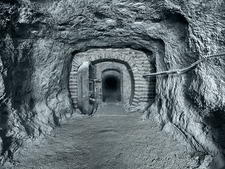
 Sealing structure between Bartensleben and Marie mine
Sealing structure between Bartensleben and Marie mine
An ordinance under mining law provided for a second shaft as escape route for mining. After that, the Bartensleben mine was constructed in Morsleben in 1910 and connected to the Marie mine.
With interruptions, rock salt was mined here until 1969. The history of the Morsleben repository for radioactive waste started in 1971.
Significance of mining for the operation and decommissioning of the repository
In the past, single large pieces of rock fell from the ceiling in the central part of the Bartensleben mine. This was caused by the high excavation ratio and was thus a direct consequence of mining. The Federal Office for Radiation Protection (BfS) has meanwhile carried out extensive stabilisation measures in the central part.
Another result of mining are places where water from the overburden or originating from the time where the salt structure formed is collected. These places are observed and monitored on a regular basis.
As a result of the former mining operation, the mine has now a cavity volume of 8 – 9 million cubic metres. Such a large number of cavities presents a challenge for the safe decommissioning of the repository. The concept for the decommissioning of the repository provides for backfilling of the major portion of the cavities with salt concrete.
This mine's history in brief| Year | Event |
|---|
| 250 million years ago | Salt forming and subsequent generation of the salt structure |
| 1861 | World-wide, first mining of potash in Staßfurt, Saxony-Anhalt |
| 1897 - 1898 | The businessman Gerhard Korte commissioned the construction of a mine in Beendorf and named it after his wife Marie |
| 1898 - 1923 | Mining of potash salts in Marie mine |
| 1910 - 1912 | Construction of Bartensleben mine in Morsleben: The mine was connected underground to the Marie mine |
| 1912 - 1918 | Mining of potash salt in the Bartensleben mine. The salt was processed on the premises of the Marie mine |
| 1918 - 1969 | Production of rock salt in the Bartensleben mine. The table salt was sold as "Sun salt from Bartensleben" |
State of 2017.01.03
1934 – 1945: Armaments production and forced labour in National Socialism
- Between 1937 and 1944, the air force used the Marie mine to develop an ammunition plant at the surface and to store aircraft ammunition underground.
- From 1944 until the end of World War II in 1945 the entire mine was confiscated for armament production. Concentration camp prisoners from the Neuengamme concentration camp were forced to produce armaments underground. The work killed many people.
- Today the repository is also a memorial site for survivors and their next of kin
The sub-camp Helmstedt-Beendorf
In the middle of 1942, armament companies and businesses demanded concentration camp prisoners be used as work forces. Concentration sub-camps were established to accommodate these prisoners. A sub-camp of the Neuengamme concentration camp was built in Beendorf: From March 1944 a men's camp for about 800 concentration camp prisoners used for building works and from August a women's camp for up to 2,500 concentration camp prisoners for armament production.
The prisoners slept in primitive, unheated storage halls of the former ammunition factory. From autumn 1944 the camp was overcrowded. The food rations for the prisoners were insufficient and most of the prisoners were always hungry. Prisoners who were terminally ill were taken to other camps.
Eventually, the number of prisoners increased to 4,500. Designed for about 2,000 persons, the camp was thus completely overcrowded.
Armament production underground

 Arms production underground
Arms production underground
From 1944, the SS deployed about 2,500 female prisoners in armament production in the Bartensleben and Marie mine. They worked for the Askania factory in the Bartensleben mine and Luftfahrtgerätewerk Hakenfelde in the Marie mine. Supervised by German and foreign skilled workers, they manufactured electro-mechanical components such as control units and steering gear for the V1 and fighter aircraft.
Under time pressure, the prisoners did very hard work. As a result of the insufficient diet and the high work load, the prisoners were weak and sick. The exhausting work killed many people in the building squads.
From the evacuation of the camp until today
The evacuation of the camp on 10 April 1945 extended the misery of the prisoners by weeks. At the time of evacuation over 4,000 prisoners were in the camp. In freight wagons and without food, they were taken to other places. The exertions killed over 500 people.
The male prisoners were freed by US soldiers in Wöbbelin. The female prisoners arrived in the already evacuated Hamburg sub-camps, from where they could be evacuated and saved by the Swedish Red Cross.
When the war was over, not all perpetrators were held accountable for the crimes committed in the Helmstedt-Beendorf sub-camp, despite of several court proceedings.
At the end of the war, the Marie and Bartensleben mines were located within the Soviet occupation zone and later on in the Border Area of the GDR. Commemoration of the victims was only possible to a limited extent. In the centre of Beendorf, a memorial stone and, on the cemetery, a mass grave remind of the victims. Only since 1989, have survivors had the option to visit this location as memorial site.
Exhibitions on the mine's history in National Socialism
The Federal Office for Radiation Protection (BfS) presents the repository’s history in an exhibition at the Info Morsleben. An important part of the exhibition is the mine's use for armament production.
In Beendorf, a small exhibition commemorates the concentration sub-camp. The exhibition also displays a collection of documents on armament production in Beendorf.
The key data in brief| Year | Event |
|---|
| 1934 - 1937 | Lease of Marie mine to the air force |
| From July 1937 | Expansion and use of Marie mine as air force ammunition plant |
| March 1944 | Construction of a sub-camp of the Neuengamme concentration camp in Beendorf and fitting out of production facilities underground |
| End of May 1944 | Armament production underground launched |
| 10 April 1945 | Evacuation of the concentration sub-camp in Beendorf |
| From 1990 | Former concentration camp prisoners and their next of kin could again visit the premises of the concentration sub-camp |
State of 2017.01.03
1958 - 1996: Chicken production and interim storage of toxic waste in the GDR
- In the former GDR chicken were produced in the Marie mine, while the repository we know today was being constructed in the Bartensleben mine. Later on toxic waste was stored intermediately in the Marie mine.
- From 1971, low-level and intermediate-level radioactive wastes were disposed of in the Bartensleben mine. Small amounts of radioactive waste were stored intermediately.
Chicken production in the Marie mine
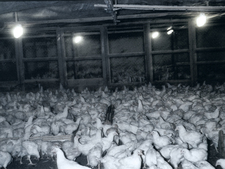
 Chicken farming underground
Chicken farming underground
In 1958, on their 5th party conference, the SED decided to increase the production of consumer goods. Within seven years, the chicken production was to increase by 700 per cent. Former chambers in the Marie mine where armament had been produced were fit out for chicken farming.
Until 1984 the mine was used for chicken production. During this period about 15,000 tons of poultry were produced. Part of the waste water accrued remained underground. Slaughterhouse operation stopped in 1990.
Interim storage of toxic waste in the Marie mine
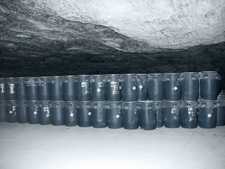
 Drums containing toxic wastes stored intermediately
Drums containing toxic wastes stored intermediately
In 1985, the GDR Council of Ministers decided to temporarily store drums filled with cyanide-containing hardening salts in the Marie mine. Parts of the toxic wastes had already been stored in two boiler rooms in Beendorf under conditions that were harmful to the environment.
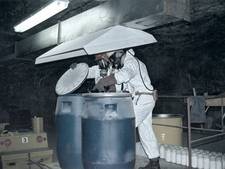
 Examination of a drum prior to relocation
Examination of a drum prior to relocation
No experience was available on underground storage. The waste producers therefore had to carry out tests on the storage behaviour. Safety concerns relating to the radioactive waste repository were assessed. From 1987, following trial phases, the wastes were then stored in chambers that had served as storage facilities in National Socialism. The 20,000 drums were relocated by 1996.
Repository for radioactive waste in the Bartensleben mine
Parallel to chicken production and interim storage of toxic waste in the Marie mine, the former GDR used the Bartensleben mine as a repository for radioactive wastes. Solid and liquid radioactive wastes were disposed of. Furthermore, radioactive wastes were stored intermediately. The general public in the GDR was badly informed.
The key data in brief| Year | Event |
|---|
| 1959 - 1984 | Chicken production in the Marie mine
|
| Until 1969 | Mining of rock salt in the Bartensleben mine |
| From 1971 | Disposal of radioactive wastes in the Bartensleben mine |
| 1987 - 1996 | Interim storage of toxic hardening salts in the Marie mine, 1995 – 1996 retrieval of the wastes |
State of 2017.01.03
1970 - 1990: Repository of the former GDR
- For monetary reasons, the former GDR examined only existing salt mines when searching for a repository site.
- The emplacement of radioactive wastes was already launched in 1971 before the repository was licensed and structural preparations were completed.
- According to today's criteria, the mine would not have been licensed as a repository.
Site selection and licensing procedure
In 1966, the Rheinsberg nuclear power plant was commissioned as the first NPP in the GDR. Concepts for the disposal of radioactive wastes did not exist at that time. The former GDR searched a site for a repository for radioactive wastes. For monetary reasons, the GDR only examined already existing salt mines.
The Bartensleben mine in Morsleben was selected in 1971 and a multi-stage procedure was initiated. Since space had become scarce in the Lohmen interim storage facility in Saxony, radioactive wastes were already emplaced in 1971 before the licence was granted. The licence for the site was granted in 1972.
In 1978, a three-year-lasting trial operation of the repository started. After the licence for fixed-term permanent operation had been granted in 1981, the licence for permanent operation was granted in 1986.
Emplacement of radioactive wastes

 Drum reloading prior to licencing and construction of the repository, 1972
Drum reloading prior to licencing and construction of the repository, 1972
The Soviet Union where the fuel elements originated from, took back high-level radioactive wastes. Low-level and intermediate-level radioactive wastes had to be managed by the GDR itself. The emplacement of radioactive wastes was already launched in 1971 before the repository was licensed and structural preparations were completed. Later on, solid and liquid radioactive wastes were emplaced, testing and adapting several different methods.
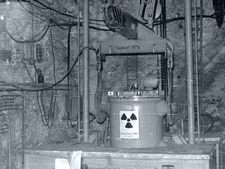
 Drum container in the dumping device, 1983
Drum container in the dumping device, 1983
Solid wastes were stacked in drums, placed without packaging or dumped from above into emplacement chambers. Liquid wastes were solidified with brown coal filter ash. Due to problems arising, the Federal Office for Nuclear Safety and Radiation Protection temporarily prohibited the procedure in 1982. The emplacement of liquid wastes ended in 1990.
The key data in brief| Year | Event |
|---|
| 1970 | Preliminary site selection
|
| 1971 | Advance emplacement of radioactive wastes |
| 1972 - 1974 | Trial emplacement with mining technology |
| 1974 - 1978 | Conversion of the facilities to a repository |
| 1978 - 1981 | Trial operation of the repository |
| 1981 | Fixed-term licence for 5 years
|
| 1986 | Permanent operating licence |
| 3 October 1990 | Reunification: The Federal Office for Radiation Protection became operator of the repository |
State of 2017.01.03
Since 1990: Pan-German repository
- After German reunification, the Morsleben repository for radioactive waste was transferred to the area of responsibility of the Federal Republic of Germany. The Federal Office for Radiation Protection (BfS) became the operator of the repository.
- The permanent operating licence granted by the GDR was considered a factual plan-approval decision.
- Emplacement operation of low-level to intermediate-level radioactive waste was resumed in 1994.
- Following a fundamental reappraisal, the BfS irrevocably waivered the acceptance of further radioactive wastes and their disposal in the Morsleben repository in 2001.
Based on the Unification Treaty, the Morsleben repository for radioactive waste was transferred to the area of responsibility of the Federal Republic of Germany after German reunification – the Federal Office for Radiation Protection (BfS) became the operator of the repository. The permanent operating licence granted by the GDR was considered a factual plan-approval decision which continued to be effective until 30 June 2000.
Right from the start, the transition of the GDR operating licence without carrying out a plan-approval procedure required for the construction of a repository was disputed in the public. On 20 February 1991 emplacement operations discontinued on account of a provisional order of the Magdeburg District Court. This provisional order was cancelled by the Federal Administrative Court on 25 June 1992, though. Emplacement operation of low-level to intermediate-level radioactive waste was resumed in 1994.
On 13 October 1992, the Federal Office for Radiation Protection – upon order given by the Federal Environment Ministry (BMU) – submitted the application for the initiation of a plan-approval (licensing) procedure for further operation beyond the year 2000 to the competent Ministry of Agriculture and Environment of Saxony-Anhalt (MLU). In 1997, the BfS restricted this application to the decommissioning of the Morsleben repository.
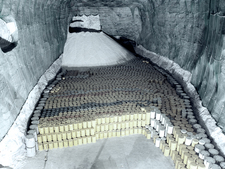
 Radioactive waste in the eastern field
Radioactive waste in the eastern field
However, based on an amendment to the Atomic Energy Act, the operating permit was extended in 1998 until 30 June 2005. The government of the federal state of Saxony-Anhalt filed a complaint to the Federal Constitutional Court against the extension. In November 1997, the Saxony-Anhalt association of the environmental organisation BUND filed a suit, because no plan-approval procedure had been carried out for the storage of radioactive wastes in the eastern field and the eastern field was not part of the GDR permanent operating licence of 1986. In September 1998, an application for an injunction regarding waste emplacement at the Magdeburg Higher Administrative Court was successful – further emplacement in the western field was prohibited until a final court decision would be issued on the merits of the case. Thereupon the BfS discontinued the acceptance and emplacement of radioactive wastes altogether.
Following a fundamental reappraisal, the Federal Office for Radiation Protection irrevocably waivered the acceptance of further radioactive wastes and their disposal in the Morsleben repository in 2001, as this was no longer justified for safety reasons.
State of 2017.01.03

![]() Marie mine - historical view 1922
Marie mine - historical view 1922








